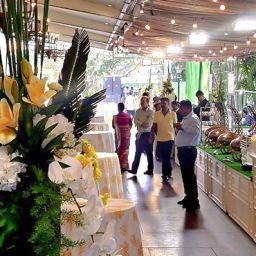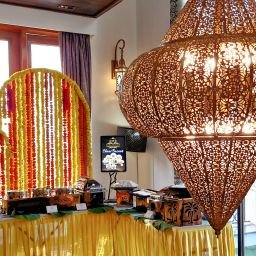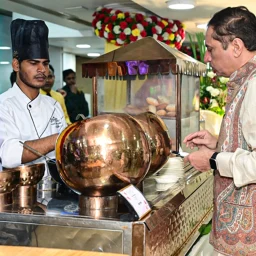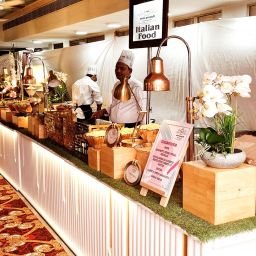
What Makes Indian Wedding Catering So Special?
Indian weddings are renowned for their vibrant traditions, elaborate ceremonies, and, most importantly, their food. Indian wedding catering goes beyond merely serving food; it’s an essential element that reflects the culture, regional flavors, and diversity of the event.
The grand feast offered at an Indian wedding is an experience of its own, carefully curated to impress and satisfy guests from all backgrounds.
In this blog, we’ll explore what makes Indian wedding catering so unique and why it holds a central place in the wedding experience.
1. Diversity of Cuisines and Regional Flavors
India is a country of diverse cultures and cuisines, and Indian wedding catering reflects this variety beautifully.
Depending on the couple’s heritage and preferences, the wedding menu can include North Indian, South Indian, Bengali, Gujarati, Rajasthani, and even fusion dishes that blend different regional flavors.
Regional Specialties
- North Indian: Dishes like Butter Chicken, Dal Makhani, and Paneer Tikka are staple choices at North Indian weddings, known for their rich, creamy gravies and bold spices.
- South Indian: Coconut-based curries, Dosa, Sambar, and Idli are common, reflecting the flavors of the southern states.
- Gujarati: Known for its sweet-and-sour flavors, Gujarati wedding menus often include dishes like Dhokla, Thepla, and Undhiyu.
- Bengali: Fish curries, mustard-based dishes, and sweets like Rasgulla and Sandesh bring a unique taste to the table.
This variety allows guests to enjoy a culinary journey across India, making Indian wedding catering a diverse and inclusive experience.
2. Traditional and Ritualistic Significance of Food
In Indian culture, food is not just for sustenance but is also a symbol of love, hospitality, and tradition.
Many Indian weddings incorporate specific dishes or sweets that hold ritualistic significance, reflecting blessings and good wishes for the couple. For example:
- Haldi Ceremony: Dishes made with turmeric, such as sweetened rice or ladoos, are sometimes served to honor the haldi ritual.
- Sagan Ki Thaali: In some North Indian communities, special thalis are prepared and blessed as a mark of prosperity and fertility for the newlyweds.
- Sweet Offerings: Desserts like Gulab Jamun, Jalebi, and Barfi are more than just treats—they represent joy, auspicious beginnings, and celebrations.
This cultural richness embedded in Indian wedding catering elevates the dining experience beyond mere flavors, adding depth and meaning to the meal.
3. The Art of Live Food Stations and Interactive Dining
Indian weddings are known for their grandeur, and one of the highlights of Indian wedding catering is the use of live food stations.
These interactive stations allow guests to see their food being prepared fresh, adding an element of excitement and engagement.
Popular Live Stations in Indian Weddings
- Chaat Counter: A station offering popular Indian street foods like Pani Puri, Sev Puri, and Bhel, customized to each guest’s preference.
- Tandoor Station: Freshly grilled items like Tandoori Paneer, Tandoori Chicken, and Kebabs are prepared in real-time, adding a smoky aroma to the event.
- Dosa and Uttapam Stations: Particularly popular in South Indian weddings, where guests can customize their toppings and fillings.
- Pasta and Noodle Bars: For a fusion twist, many caterers include pasta and noodle stations that allow guests to pick their sauces and add-ons.
Live food stations make Indian wedding catering interactive and fun, ensuring that each guest has a memorable dining experience.
4. Lavish Appetizers and Starters
Indian weddings typically begin with an elaborate spread of appetizers, setting the tone for the feast to come.
Appetizers in Indian wedding catering are designed to excite the palate, offering a mix of traditional and modern flavors.
From finger foods to street food-inspired bites, the options are endless.
- Paneer Tikka: A tandoor-cooked dish where paneer is marinated in spices and grilled to perfection.
- Tandoori Prawns: Marinated prawns cooked in a tandoor, offering a delightful smoky flavor.
- Mini Samosas and Kachoris: Classic Indian snacks served with tangy tamarind and mint chutney.
- Pani Puri Shots: A contemporary twist on the popular street food, served as an interactive, bite-sized treat.
These appetizers keep guests entertained as they wait for the main course, making them an essential part of Indian wedding catering.
5. A Grand Main Course Spread
The main course at an Indian wedding is a feast in itself, featuring a vast array of dishes that include vegetarian and non-vegetarian options, a variety of breads, rice dishes, and much more.
This grand spread is designed to cater to a wide range of tastes and preferences, allowing each guest to indulge in flavors they love.
Vegetarian Main Course
- Dal Makhani: A rich, creamy black lentil dish, slow-cooked for hours to enhance its depth of flavor.
- Shahi Paneer: Soft paneer cubes cooked in a creamy tomato gravy, a favorite at North Indian weddings.
- Aloo Gobi: Potatoes and cauliflower spiced with turmeric and cumin, a popular North Indian dish.
- Bhindi Masala: Stir-fried okra with onions and tomatoes, a delicious addition for vegetarian guests.
Non-Vegetarian Main Course
- Butter Chicken: Tender chicken pieces cooked in a rich, buttery tomato sauce, a staple at Indian weddings.
- Mutton Rogan Josh: A Kashmiri-style mutton curry with bold flavors, often paired with naan or rice.
- Fish Curry: A coastal favorite, featuring fresh fish in a spicy coconut-based curry.
- Chicken Biryani: Fragrant basmati rice layered with spiced chicken, saffron, and aromatic spices.
These main courses in Indian wedding catering ensure that guests experience a royal feast, capturing the flavors of India.
6. Mouth-Watering Desserts and Sweet Treats
Indian weddings are known for their indulgent dessert spreads. Indian wedding catering includes an assortment of traditional Indian sweets as well as modern desserts, giving guests the perfect ending to their meal.
Classic Indian Sweets
- Gulab Jamun: Soft, deep-fried dough balls soaked in sugar syrup, a favorite at every Indian wedding.
- Ras Malai: Soft paneer dumplings soaked in sweet, saffron-infused milk.
- Jalebi with Rabri: Crispy, syrupy jalebis served with thick, creamy rabri.
- Kulfi: Traditional Indian ice cream with flavors like cardamom, pistachio, and saffron.
Modern Dessert Options
- Chocolate Mousse: A rich, creamy dessert for guests with a sweet tooth.
- Mini Cheesecakes: A bite-sized treat that adds a contemporary touch to the dessert spread.
- Macarons and Pastries: Colorful, delicate treats for guests looking for international flavors.
This variety of sweets makes Indian wedding catering both traditional and versatile, ensuring that every guest leaves with a sweet memory of the event.
7. Hospitality and Impeccable Service
One of the factors that make Indian wedding catering so special is the hospitality extended by the catering staff. Indian weddings are known for their warm and welcoming atmosphere, and caterers play a significant role in upholding this tradition.
The catering team is trained to offer polite and attentive service, ensuring that every guest feels valued and taken care of.
From refilling dishes to managing live stations and ensuring every table is attended to, excellent service enhances the entire dining experience.
Conclusion
Indian wedding catering is much more than just a meal; it’s an integral part of the wedding that captures the spirit, culture, and diversity of the celebration.
With a variety of regional dishes, live stations, lavish main courses, and indulgent desserts, Indian wedding catering is a feast for the senses, leaving guests with cherished memories of the event.
Whether it’s traditional flavors or modern twists, Indian wedding catering provides a culinary experience that is as unique and grand as the wedding itself.
















